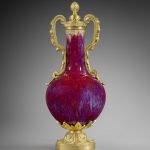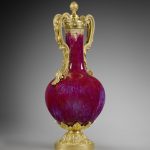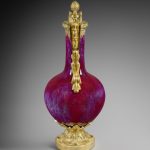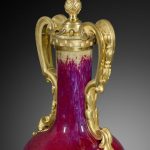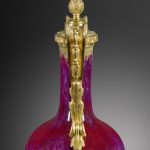A Chinese flambé glazed porcelain covered vase
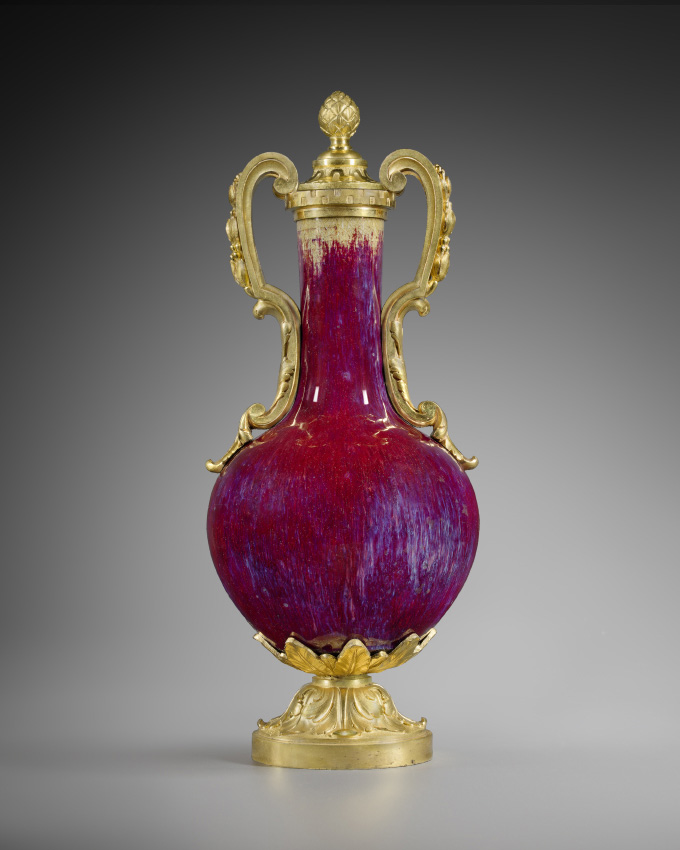
A late Louis XV gilt bronze-mounted Chinese flambé glazed porcelain vase
circa 1765
The porcelain Qianlong Period (1736-1795)
Height: 31 cm. (12 ¼ in.) Width: 12.5 cm. (5 in.)
Diameter of base: 8.5 cm. (3 ¼ in.)
Provenance
Probably collection of Sophie Arnould (1740-1802); her sale, Paris, 30-31 December 1778, lot 56
Acquired by Samuel Cunliffe-Lister, 1st Baron Masham of Swinton (1815-1906), circa 1890 for Swinton Park, North Yorkshire
Thence by descent to his grand-daughter and heir Mary Constance “Molly” Boynton (1890-1974), who married Philip Lloyd-Greame (who took the name Cunliffe-Lister), later 1st Earl of Swinton, and by descent to the Trustees of the Lord Swinton Will Trust
Literature
Émile Dacier, ‘Le catalogue de la vente Sophie Arnould illustré par Gabriel de Saint-Aubin’, Revue de l’art ancien et moderne, vol. 26, no. 152 (10 November 1909), pp. 353-360.
Comparative literature
A pair of larger-scale flambé bottle vases whose slightly later mounts include the same distinctive Greek key banded lid are in the British Royal Collections (inv. RCIN 2316; J. Ayers, Chinese and Japanese Works of Art in the Collection of Her Majesty The Queen, London, 2016, pp. 585-586, nos. 1389-1390).
This Chinese porcelain vase with a flambé red ground tinged with purple presents over its entire surface a shiny and slightly cracked glaze characteristic of Chinese production from the Qianlong Period (1736-1795). The bottle shape is formed by a circular body supporting a high, narrower neck. At its base, the bottle rests on a gilt bronze mount whose circular pedestal is formed of an ogee enriched with acanthus leaves on a granulated ground; separated by a ring, the upper part presents an alternation of leaves of varying length which serves to hold the bottle. Also in gilt bronze and distributed symmetrically along the neck, the two contoured handles formed by leafy scrolls are distinguished by the presence of a drop of seeds in the upper part. The moulded neck of the bottle is punctuated with a small square granulated pattern. The lid displays interlacing on a granulated ground and is finished with a pinecone.
The collection of Sophie Arnould, opera singer
Well known to the Parisian public for the quality of her acting and her voice, Sophie Arnould (1740-1802) began a brilliant career as an actress and singer at the age of seventeen (fig. 1). She had many lovers including a long affair with Louis-Léon-Félicité de Brancas, 3rd Duc de Lauraguais (1733-1824), with whom she had four children. Close to the best painters and sculptors of her time, several likenesses of Mademoiselle Arnould are known, including one by Jean-Baptiste Greuze (1725-1805) now in the Wallace Collection in London (inv. P413).

Fig. 1 – Louis Carrogis de Carmontelle (1717-1806)
Portrait of Sophie Arnould in the opera Pyramus and Thisbe, 1760
Watercolour, gouache, ink and graphite on paper. Chantilly, musée Condé (inv. Car 420)
Renowned for her grace and witticisms, Sophie Arnould had a true passion for paintings and luxurious art objects. She frequented the auction rooms, participating in the Gaignat sale in 1768, the Blondel de Gagny sale in 1776 and the Randon de Boisset sale in 1777. She was also sketched during the Lauraguais sale in March 1772 by the famous designer, Gabriel de Saint-Aubin (1724-1780) (Paris, musée du Louvre, inv. RF 52287). Arnould retired from the opera stage in 1778 and decided to part with some of her collections. The catalogue for her sale, written by the expert Alexandre-Joseph Paillet (1743-1814), was printed as a supplement to that of the painter Charles-Joseph Natoire (1700-1777). The catalogue described Mademoiselle Arnould’s collection as :
« de plusieurs tableaux originaux, belles porcelaines anciennes, de la Chine, du Japon, de Saxe, garnies de bronzes dorés d’or moulu, beaux meubles, coffres de laque, bibliothèques en bois d’acajou, et autres objets curieux »
(“composed of several original paintings, beautiful old porcelains from China, Japan, Saxony, garnished with mercury gilt bronze, beautiful furniture, lacquer chests, mahogany bookcases, and other curious objects”)
The sale took place on 30-31 December 1778. This covered vase with two handles in Chinese red flambé porcelain seems to correspond to lot 56 (fig. 2):

Fig. 2 – Extract from the Sophie Arnould sale catalogue, 30-31 December 1778
« Une bouteille, forme oblongue, de porcelaine Jaspée, garnie de pieds ronds à feuillages, gorge et anses contournées, forme de Lyre, avec couvercle en bronze, terminée par une pomme de pin »
(“An oblong shaped bottle, in jaspered porcelain, mounted with a round foot with foliage, a neck, and Lyre shaped contoured handles, with a bronze lid ending with a pinecone”)
Among the other porcelain sold by Sophie Arnould in 1778, two gilt bronze-mounted potpourris were lot 42. These Chinese turquoise porcelain pieces later appeared, like this bottle, in the English collections of Samuel Cunliffe-Lister (1815-1906) at Swinton Park.
The Swinton Park collections

Fig. 3 – Swinton Park, Masham, North Yorkshire
© 2024 Swinton Park Limited

Fig. 4 – John Collier (1850–1934),
Portrait of Samuel Cunliffe-Lister (1815-1906), 1st Baron Masham of Swinton. Oil on canvas, 1901
Bradford Museums and Galleries (inv. 1901-001)
Swinton Park near Masham in North Yorkshire was built at the end of the 17th Century and subsequently enlarged by its successive owners (fig. 3). The estate was bought in 1883 by Samuel Cunliffe-Lister (1815-1906), 1st Baron Masham of Swinton (fig. 4), who considerably embellished the interiors with new acquisitions of highly important paintings, 18th Century French furniture and a rare collection of gilt bronze-mounted porcelain. Through his refined taste and thanks to his network of scholarly friends and antique dealers, the 1st Baron Masham by the end of the 19th Century was considered one of the great collectors of French decorative arts of the Ancien Régime.
Samuel Cunliffe-Lister’s fortune came partly from the industrial empire developed by his father around the manufacture of textiles, but he was himself a great inventor, filing more than one hundred and fifty patents, and he played a decisive role in the development of the textile industry in England. The Manningham Mills site he controlled became the largest silk and velvet spinning mill in the world. In 1888, the company employed nearly 5,000 people, and at its peak, 11,000.
Cunliffe-Lister married in 1854, but his wife died prematurely in March 1875 after leaving him several heirs. Ennobled with the title of Baron Masham of Swinton on 15 July 1891, he died a few years later, on 2 February 1906 at Swinton Park. The Swinton estate remained in his family until 1980. His descendants sold various mounted porcelains of exceptional quality at Christie’s London on 4 December 1975.
Vincent Bastien, Doctor in History of Art

